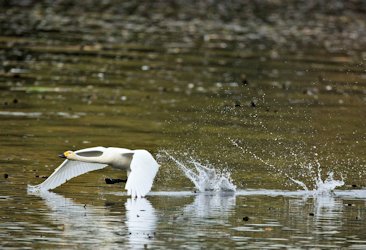
|
Taking Off Bird Flight
Birds and airplanes face into the wind when taking of or landing so they can take advantage of wind speed. If the wind were at their backs, they would not have the control they have when facing into it. But differences exist here too: While large birds need a prolonged takeoff run to become airborne, small birds can jump straight into the air on takeoff; they can generally achieve lift from zero air speed. Larger birds can fly at speeds within a minimum and maximum range, but they cannot take flight at zero air speed. Therefore, larger birds need to generate air speed before they can take off. The often run over the ground or water until they reach the minimum air speed needed to take flight. A Tundra Swan rises laboriously from a pond. To lift into the air, it must propel forward over the water to gain flight speed. |
|
Large terrestrial birds such as eagles and hawks land on an elevated perch or a hill whenever possible so that they can acquire flying speed by dropping off of the perch. Seabirds achieve the same result by accelerating down the windward slope of large waves or by paddling over the surface while flapping energetically. Hang gliders operate on a similar principle for takeoff. Because of a hang glider's enormous wingspan and the relative heavy weight supported by its "wings," the flier must always head into the wind, preferably from a sloped hill or mountain top, to attain the minimum flying speed for lift. Large land birds taking off from the ground run with steps synchronized to their wingbeats. In a motion that resembles running, most North American water birds use their webbed feet to push themselves forward through the water for takeoff; this motion is also synchronized with the wingbeats. |
|